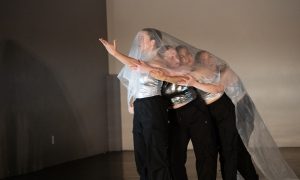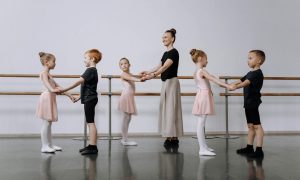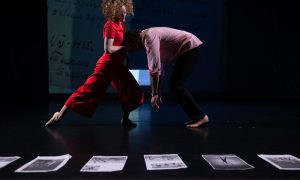The Plimpton Shattuck Theater, Boston, MA.
January 15, 2023.
I was waiting for Company SBB // Stefanie Batten Bland’s Look Who’s Coming to Dinner to start (the New York City-based company touring in Boston). Per usual when I take in shows to review, I assembled my materials to take notes, browsed the program and eyed the stage space. Not quite per usual, one of the ensemble members sat next to me and started chatting with me.
She was jovial and authentic, yet I also chuckled to myself to think that her work of performing was starting; most likely, she was executing an improvisational ”script” of interacting with audience members before the house lights came down and the action on stage started. (I saw her do the same with other audience members after we briefly talked, and fellow ensemble members also chat with audience members.)
Just moments later, she was moving under the stage lights (lighting design by Yuki Link, adapted from Clifton Taylor) – the proscenium space imbuing her with a new sort of presence, one of the persona of this work and not of herself. As did the performance overall, this development had my mind whirring — on questions of transformation, of human interaction, of the roles we play, of questioning the very nature of things as we’ve been told they are.
That opening moment felt like far more than a moment; the atmosphere took its time to build (technical direction from Emma Rivera). The performers stood in tableau, evenly spaced across the downstage – order and predictability permeating. Dancers began to move – in turn – and thus deconstruct that order and predictability, however. Posing again, they shifted back into that sense of static order.
The tension between opposites, the shifting between those poles, and the unpredictability of where along that spectrum what was transpiring before us would land: that was all emerging here, like greens sprouting out of newly-thawed spring earth. It would grow ever clearer and more poignant. Soon, dancers began moving with more size, speed, and technical virtuosity – yet an understated atmosphere continued to permeate.
Even in this first “dancey” section of the work, Batten Bland’s Gaga roots were clear — layers to peel back and savor, yet nothing superfluous, nothing to sour through being ostentatious. Soon, the action returned to something more quotidian: dancers setting up tables and laying tablecloths over them (installation also by Batten Bland), while audio spoke of preparing for dinner guests (music by Paul Damian Hogan). These actions infused a sense of the traditional and the familiar — qualities that would also be deconstructed before long.
Indeed, a guest arriving added turbulence to the social order in the space – as we can recognize in our own lives, the air changing in a social space with the ingredient of someone new entering. That all happened without a word, as the most intentionally crafted dance art can achieve: that conveying of unspoken feeling with the body and atmosphere alone.
Also striking to me, right from this early part of the work, was the seamlessness of transitions – even if exhibiting clear constrast, even with the accent inevitable in transition itself, the boundaries between those qualitative shifts were soft. That’s how they are in life, after all; there’s no “ta da, we’re here now” – rather, one moment follows another even as changes might rock the earth beneath us.
One transition, into an ensemble member acting like quite the “macho man” — beginning to do pushups, pose like a body builder and shadow-box – did jar me. Yet, it soon enough occurred to me that such an unsettled feeling, of encountering something unexpected, was likely intentional. The same went for more aggressive physicality between the personas on stage, agitated vocalizations adding more sensory color.
Something sweeter filled the air again soon, however, those vocalizations turning into laughter. My mind could chew on layers of possibility here: for example, the agitation being the unspoken unresolved things between us, the unspoken anxieties and hurts, and the laughter being the social mask we put on? A similar moment transpired later: pleasantries exchanged face-to-face but anger and insults expressed behind closed doors.
That fodder for mental chewing can be one of the most exciting parts of works like this one. There was plenty on offer for the senses to chew on, as well — the ensemble pounding rhythms on the table, Hogan’s layered and mercurial score, Batten Bland’s movement vocabulary oozing out of clear form into new clear form.
Most of this remained abstract, yet truthful interactions between performers offered access points of relatability. Certain elements also grounded the action in narrative: the chirping of crickets and the lights dimming to signify night falling, for example. Cultural touchpoints, such as one performer singing a version of Aretha Franklin’s “R.E.S.P.E.C.T” with lyrics changed to discuss COVID-related matters (the CDC and vaccines, for example).
With such unpredictable shifts in quality, and mysteriously abstract interactions, these were points which we in the audience could reach for just as rock climbers latch unto secure pieces of rock. Those unpredictable elements continued with the tables flipped on their side and one of the performers smoothly, athletically dancing over and around it. It seemed that clear kinetic integration, combined with efficient use of pure strength, propelled moments of defying gravity here.
In the larger scope of the work, this choice was more pushing us to question our assumptions. It once again flipped our expectations – figuratively and, with tables turned on their sides, arguably literally. In this instance, and in others when dancers placed the tables in unconventional ways, the space transformed just as the dancers continued to transform – as they moved through different kinesthetic and social/emotional states, varied ways of being.
More little vignettes of interaction transpired, presenting these varied states of being. These sections were particularly full of Batten Bland’s rich, yet understated movement vocabulary and her dancers’ commanding execution of it: both grounded and expanding, both soft and kinetically powered. If any given audience member might find it challenging to connect to any of the avant garde elements at hand, this movement could offer more than enough to satisfy.
The emotional truth at hand was also something any audience member could access. Poignantly, as the work drew towards a close, one ensemble member found calm through an embrace from – and calm of – another ensemble member. This illustrated co-regulation, how we can find calm through one another, in a more visceral and embodied way than I’ve yet seen it illustrated.
Storms return, however, because that’s just reality; a few ensuing sections brought more of that frenetic, unsettled quality. The point is not avoiding those storms, but finding clear skies again. And that the performers did, or at least some of them; a memorably easeful and integrated solo followed these more agitated sections. In contrast, it evoked harmony.
Tender gestures brought this sense of inner harmony to one of interpersonal peace. Soon after that, the ensemble gathered all together upstage as the lights lowered, holding hands. As I experienced that moment, I thought that so much was possible from there – as if simply awed by the immensity of all of that multiplicity, and it fully occupying my mental space.
Reflecting now, as I write this, what feels most salient to me is that sense of connection and care – arguably, the point of all of that exploring different states of being and provocating our preconceptions (otherwise, why should it really matter, but to work toward the best ways to care for one another and ourselves?).
In a short post-show address, Batten Bland attested to feeling “hugged” by those the company worked with in Boston for their short time in the city. That reinforced the larger idea of community care for me. Thank you, Company SBB // Stefanie Batten Bland, for a work that hugged even as it – at times – challenged and unsettled. Whoever comes to our dinner table, may we welcome them and nurture them in similar ways.
By Kathryn Boland of Dance Informa.















